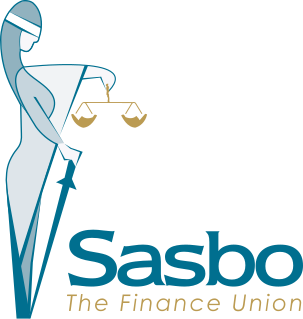Related Research Articles

SASBO – The Finance Union is a trade union in South Africa. It was founded in 1916 and has a membership of 70,000.
Trade unions in South Africa has a history dating back to the 1880s. From the beginning unions could be viewed as a reflection of the racial disunity of the country, with the earliest unions being predominantly for white workers. Through the turbulent years of 1948–1991 trade unions played an important part in developing political and economic resistance, and eventually were one of the driving forces in realising the transition to an inclusive democratic government.
The South African Trades Union Congress (TUC) was a national trade union federation in South Africa.
The Trade Union Council of South Africa (TUCSA) was a national trade union federation in South Africa.
The South African Typographical Union (SATU) is a trade union representing workers in the printing and media industries in South Africa.
The Amalgamated Engineering Union of South Africa (AEU) was a trade union representing white manufacturing workers in South Africa.
The Metal and Electrical Workers' Union of South Africa (MEWUSA) is a trade union representing workers in engineering and related trades in South Africa.
The Artisan Staff Association (ASA) was a trade union representing higher-paid technical railway workers in South Africa.
The South African Trades and Labour Council (SAT&LC) was a national trade union federation in South Africa.
The South African Iron and Steel Trades Association was a trade union representing white metalworkers in South Africa.
Henry William Sampson, often known as "Sammy", was an English-born South African trade unionist and politician.
The Cape Federation of Labour Unions (CFLU) was a trade union federation in South Africa.
James Dominic Francis Briggs was an Australian-born South African politician and trade unionist.
The Amalgamated Union of Building Trade Workers of South Africa (AUBTWSA) is a trade union representing workers in the construction industry in South Africa.
The Amalgamated Society of Woodworkers of South Africa (ASW) was a trade union representing carpenters, joiners and those in related trades in South Africa.
The South African Reduction Workers' Association (SARWA) was a trade union representing officials involved in processing mining ores in South Africa.
The South African Engine Drivers' and Firemen's Association (SAEDFA) was a trade union representing people involved in operating engines in South Africa.
The South African Equity Workers' Association (SAEWA) is a general union in South Africa.
The Hospitality Industry and Allied Workers' Union (HIAWU) is a trade union representing workers in the hospitality sector in South Africa.
The Motor Industry Employees' Union was a trade union representing workers involved in vehicle building in South Africa.
References
- ↑ Gitsham, Ernest; Trembath, James H. (1926). A first account of labour organisation in South Africa (PDF). Durban: E. P. & Commercial Printing. Retrieved 11 April 2021.
- 1 2 Lewis, Jon (1984). Industrialisation and Trade Union Organization in South Africa, 1924-1955. Cambridge: Cambridge University Press. ISBN 0521263123.
- ↑ Alexander, Peter (2000). Workers, War & the Origins of Apartheid. J. Currey. ISBN 9780852557655.
- 1 2 Touyz, Brian Martin (1982). WHITE LABOUR AND THE 'SOCIAL DEMOCRATIC' MOVEMENT IN THE TRANSVAAL; THE SOUTH AFRICAN LABOUR PARTY, THE SOUTH AFRICAN TRADES AND LABOUR COUNCIL AND THEIR TRADE UNION AFFILIATES, 1930 - 1954 (PDF). Cape Town: University of Cape Town. Retrieved 13 April 2021.
- ↑ Miller, Shirley (1982). Trade Unions in South Africa 1970-1980: a directory and statistics. Cape Town: Southern Africa Labour and Development Research Unit. ISBN 0799204692.
- ↑ "FEDUSA: Working for the nation" (PDF). South African History Online. Retrieved 25 March 2021.
- ↑ "CANCELLATION OF REGISTRATION OF TRADE UNIONS RESULTING FROM THE 2002 LRA AMENDMENTS". South African Labour Guide. Retrieved 22 April 2021.